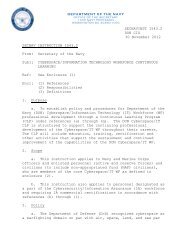HowToFormANonprofit_1st_ed-Chapter3
HowToFormANonprofit_1st_ed-Chapter3
HowToFormANonprofit_1st_ed-Chapter3
Create successful ePaper yourself
Turn your PDF publications into a flip-book with our unique Google optimized e-Paper software.
Starting A Nonprofit: What You Ne<strong>ed</strong> To Know, 1 st Ed. – Chapter 3<br />
E. Restrictions: A Summary<br />
A nonprofit’s Board and Staff must adhere to IRS and other governmental restrictions in order to<br />
retain the nonprofit’s tax exemption which the IRS has defin<strong>ed</strong> as a privilege and not a right. The<br />
only absolute prohibition is that the nonprofit, through its staff or Board, must not campaign for<br />
political candidates. The restrictions with regard to lobbying and unrelat<strong>ed</strong> business income do<br />
not prevent these activities but do limit how they may be carri<strong>ed</strong> out. Since the IRS provides<br />
alternatives, every nonprofit should be able to carry out activities important to its constituency<br />
without violating the law. As with other matters, thorough orientation for new staff, Board<br />
members, and volunteers and ongoing training is essential so that uninform<strong>ed</strong> persons will not<br />
jeopardize a nonprofit’s tax exempt status.<br />
V. Fundraising: Where should You Start? Return<br />
Fundraising for charitable organizations is simply the activity of soliciting money or pl<strong>ed</strong>ges for<br />
the operational benefit of the organization. Solicitation of funds is the critical element to the<br />
success in achieving the organization’s mission and vision. Given this importance, Charitable<br />
Solicitation Laws have been creat<strong>ed</strong> to minimize abuse of nonprofit status, protect donors from<br />
fraud and misrepresentation, and r<strong>ed</strong>uce waste of charitable money.<br />
Charitable contributions can come in various forms, including cash, securities, personal property,<br />
and real estate. All fundraising begins with an “Ask”. “Asks” are done in various forms, whether<br />
directly or indirectly, by board members, staff, and/or hir<strong>ed</strong> fundraising professionals. However,<br />
before “Asks” can begin, it is paramount that nonprofit organizations form a fundraising<br />
strategy, as well as take certain preliminary legal steps.<br />
A. Formulating Your Fundraising Strategy<br />
The following steps should be follow<strong>ed</strong> in order to identify and formulate the fundraising<br />
strategy for any charitable organization. Particular attention should be paid to the demographics<br />
of the city, as well as the companies, wealthy individuals, and foundations that already exist in<br />
the area. In addition, the organization must do extensive research on other nonprofits in the area<br />
and the particular fundraising methods that are us<strong>ed</strong> by these charities.<br />
1. Clearly define target audiences that will support the organization’s mission. The key target<br />
audiences are those foundations, organizations, government agencies, individuals, and other<br />
nonprofits that will donate the initial gifts to the organization.<br />
2. Formalize a plan for securing annual operational revenues. These typically come from<br />
Annual Giving campaigns in various forms, so an analysis of the most efficient and effective<br />
means of solicitation must be complet<strong>ed</strong>. (Methods are discuss<strong>ed</strong> later in this manual.)<br />
3. Incorporate other solicitation methods. These might include major gifts, capital campaigns,<br />
grant requests, and estate planning. Similar to Annual Giving, an analysis of the most<br />
efficient and effective means of solicitation must be complet<strong>ed</strong>. (Methods are discuss<strong>ed</strong> later<br />
in this manual.)<br />
18





